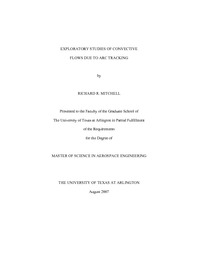
ATTENTION: The works hosted here are being migrated to a new repository that will consolidate resources, improve discoverability, and better show UTA's research impact on the global community. We will update authors as the migration progresses. Please see MavMatrix for more information.
Show simple item record
| dc.contributor.author | Mitchell, Richard R | en_US |
| dc.date.accessioned | 2007-09-17T17:07:35Z | |
| dc.date.available | 2007-09-17T17:07:35Z | |
| dc.date.issued | 2007-09-17T17:07:35Z | |
| dc.date.submitted | August 2007 | en_US |
| dc.identifier.other | DISS-1851 | en_US |
| dc.identifier.uri | http://hdl.handle.net/10106/626 | |
| dc.description.abstract | The objective of the research was to develop an understanding of how a flame propagates through an electronic enclosure. FLUENT®, a Navier-Stokes solver, was chosen due to its widespread commercial use, the availability of turbulence models and its ability to handle combustion. The relevance of this study with respect to the aerospace and domestic appliance industry was shown through case reports. Initial observations were made on arc discharges, chemical compounds and their relevance to establishing the flame.
Experimental bench tests highlighted the instigating factors for flame ignition. The first round of bench testing revealed that solder node separation played an important role in establishing an arc discharge. Next, a water/Solventol solution was added to the tests to sustain the arcing of the solder nodes. Once the arc discharge was sustained, the next round of testing moved into the initiation of the flame on a printed circuit board (PCB). The bench testing showed that a minimum solder node separation of 1mm was necessary to achieve arcing with the water/Solventol solution at 120 VDC. The results also indicated that ignition of the flame was possible after several seconds of arcing occurred on the PCB panel. A method of flame suppression, through expanded metal foil, was suggested.
The control volume was described in detail starting with the computer aided design drawing in Pro/ENGINEER. The preprocessing software GAMBIT was used to further simplify the model and to add a finite volume mesh and initial boundary conditions. The partially-premixed solver was chosen in FLUENT® with a unique incorporation of the non-premixed and premixed combustion chemistry to establish an arc and to track the flame front.
Simulation results indicated a flame front propagation with a spark discharge as the ignition source. Three- and two-dimensional contour plots were used for the flame front visualization and analysis. Additional volume-averaged analysis of the discrete phase model burnout rate, species mole fraction, temperature and progress variables show track the ignition and flame propagation in the control volume. Overall, the results indicate the successful implementation of a hybrid partially-premixed combustion model, to simulate arc tracking and flame propagation in a three-dimensional enclosure. | en_US |
| dc.description.sponsorship | Lu, Frank | en_US |
| dc.language.iso | EN | en_US |
| dc.publisher | Aerospace Engineering | en_US |
| dc.title | Exploratory Studies Of Convective Flows Due To Arc Tracking | en_US |
| dc.type | M.S. | en_US |
| dc.contributor.committeeChair | Lu, Frank | en_US |
| dc.degree.department | Aerospace Engineering | en_US |
| dc.degree.discipline | Aerospace Engineering | en_US |
| dc.degree.grantor | University of Texas at Arlington | en_US |
| dc.degree.level | masters | en_US |
| dc.degree.name | M.S. | en_US |
| dc.identifier.externalLink | https://www.uta.edu/ra/real/editprofile.php?onlyview=1&pid=274 | |
| dc.identifier.externalLinkDescription | Link to Research Profiles | |
Files in this item
- Name:
- umi-uta-1851.pdf
- Size:
- 13.45Mb
- Format:
- PDF
This item appears in the following Collection(s)
Show simple item record


